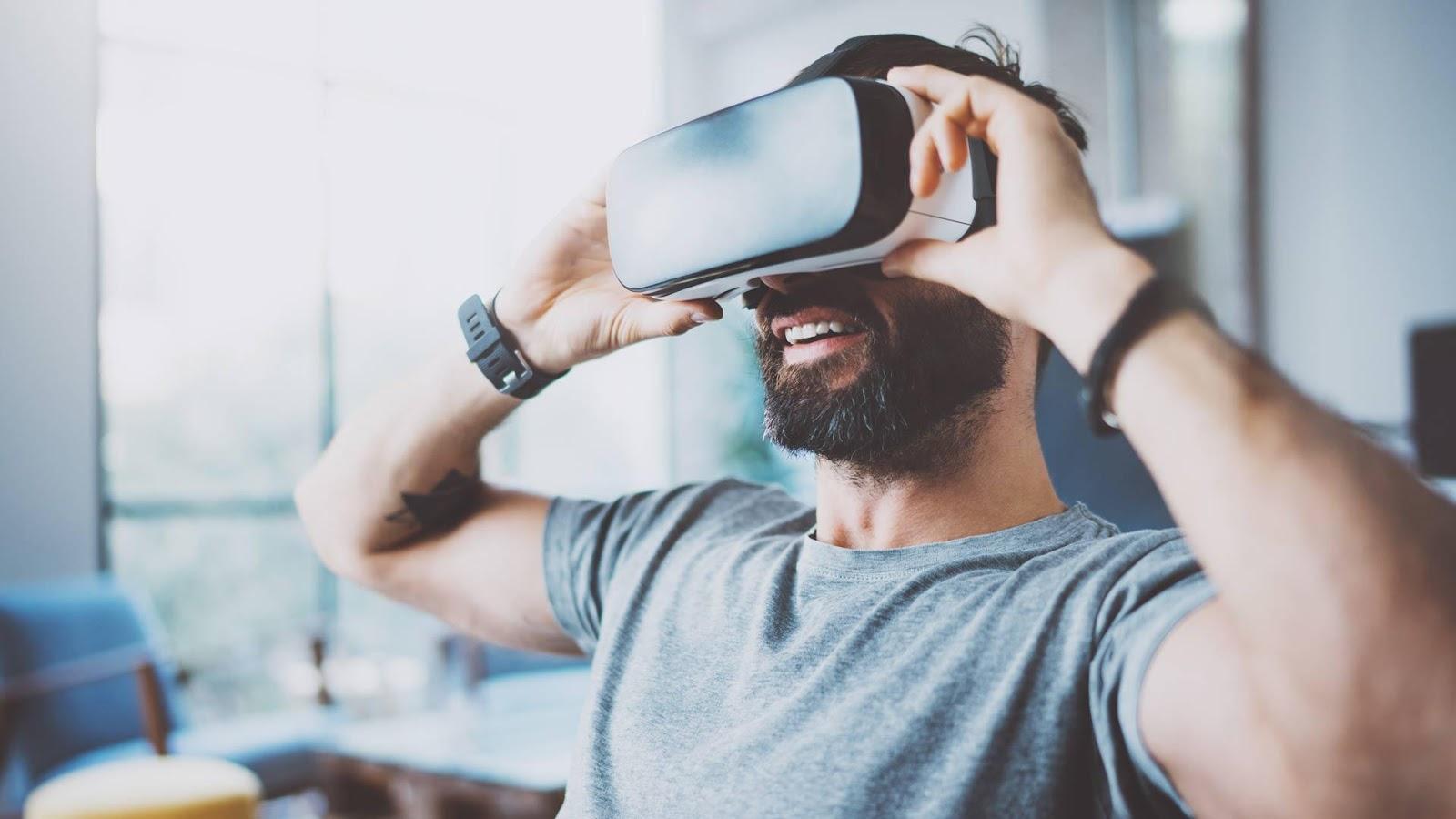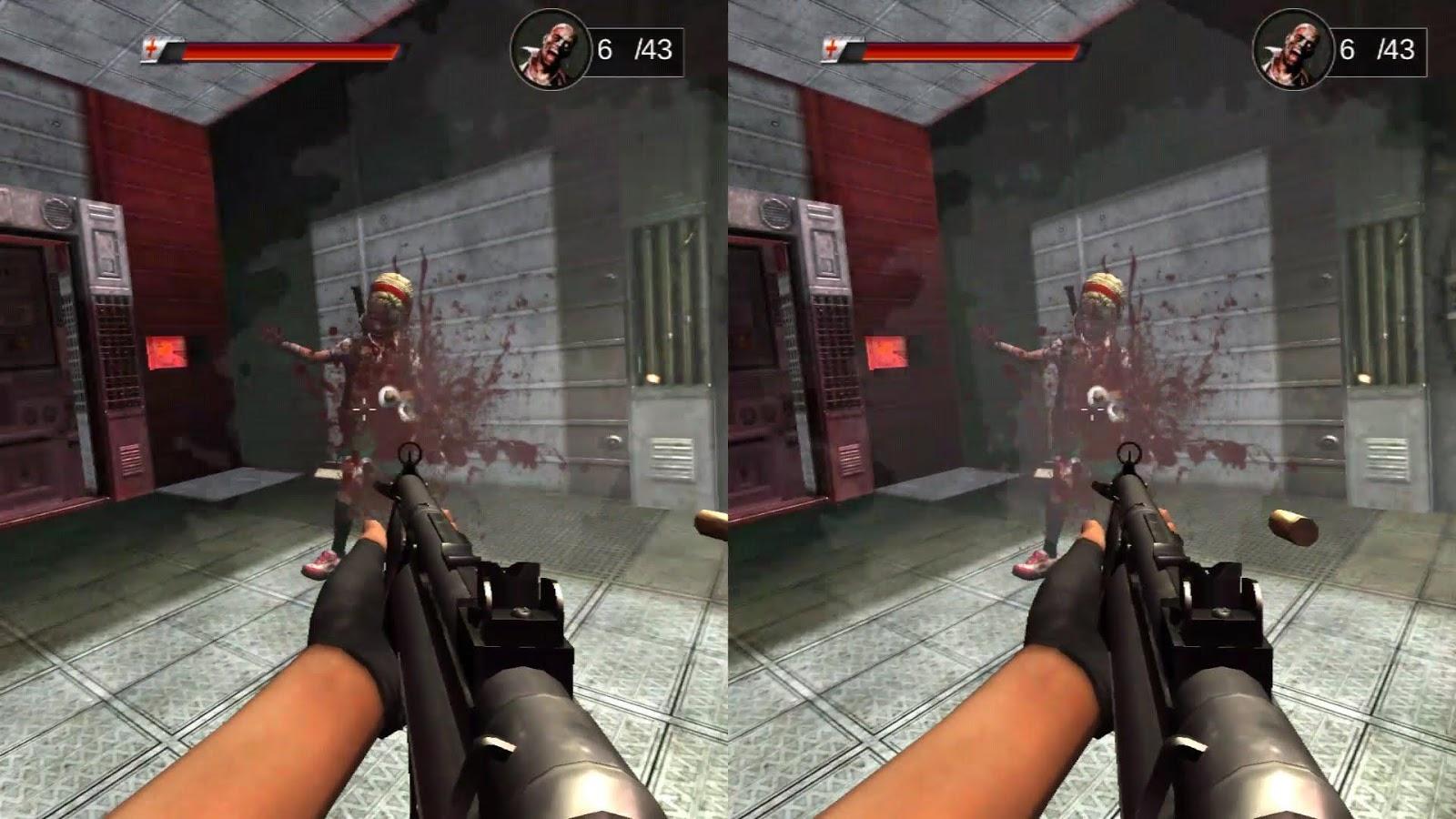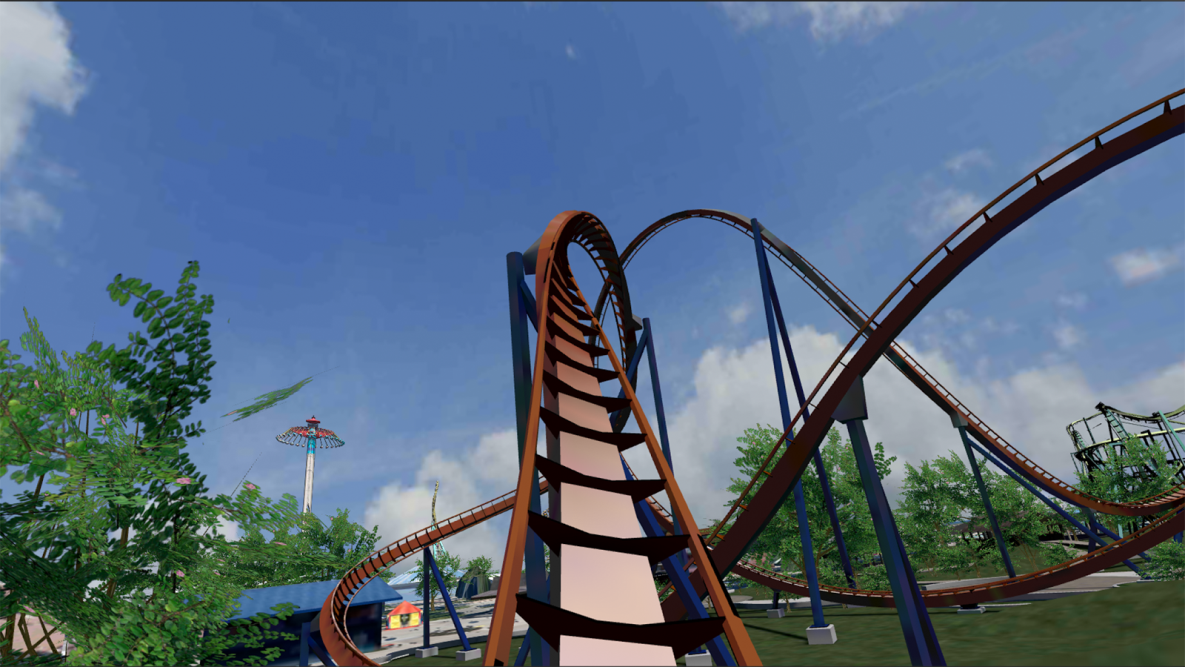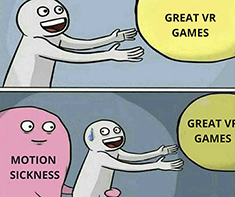Combating VR Sickness: Debunking Myths and Learning What Really Works

The major task of the virtual reality (VR) developers is to ensure full immersion in the VR world. This means that the conscious part of the brain understands the unrealistic nature of this world, while the unconscious part accepts the virtual world as reality. A poor level of immersion may lead to certain brain reactions, one of which is "VR sickness."
The ways to minimize VR sickness are well-known, and they encompass hardware and software changes. However, many of them are the myths that give the illusion of solving the problem of VR sickness, but, in fact, do not solve it.
ARVI has studied the problem of VR sickness and has come up with the conclusion that well-known methods do not work or work poorly. This conclusion is based on unique ARVI experiences, so we don’t claim them to be universal.
What is VR Motion Sickness?
Basically, VR sickness is the condition which appears due to a mismatch between the information that the person receives through his vestibular system (inner ear and brain) and the visual data.
In short, when the person moves in VR but he doesn’t move in actual life, this dissonance can appear. One of the best illustrative examples is experienced in the first-person shooter (FPS) game.

The condition begins when the players find they cannot walk through the gaming environment normally. Immediately, they start experiencing nausea and headache because there is a visual movement, according to the eyes, but this movement is not felt in the vestibular system.
Another example is found in the roller coaster game. In fact, this problem concerns not only the VR world. In real life, people also feel sick after riding a roller coaster. This happens due to the overexcitement of the vestibular system because the person is normally used to a stable position in which below he sees the earth or floor and above there is the sky or ceiling. During movement in different directions, the vestibular system undergoes a constant and intense stimulation. Therefore, it triggers kinetosis (motion sickness).

Reasons for Motion Sickness
Scientists have estimated that around 25-40 percent of people suffer from motion sickness depending on the mode of transport. Moreover, women are more susceptible than men. The people who are prone to motion sickness are more likely to suffer from VR sickness.
Thus, this issue becomes relevant both for VR developers and users. There are several reasons for this problem.
- The player’s perception
In this situation, the real position of the user is different from his position in the virtual environment. For instance, the user is sitting or lying in real life, whereas his avatar is standing in VR. It leads to the conflict between vision and balance.
- Simulator sickness
This sickness is usually experienced by pilots who undergo training for extended periods of time in flight simulators. The distinctive feature of simulator sickness is that it occurs in simulated environments and can be caused without actual motion. The major reason is that during actual flight, the body adapts to different motion conditions, but the flight simulator doesn’t provide the same conditions, and simulator sickness can occur.
- The position of the headset
The position of the headset and the display influences the level of comfort in the VR game. Some people experience eye-straining symptoms and heat.
Avoiding VR Sickness: Debunking Myths

Though VR sickness is the most common problem developers face, its effects may be minimized with some software changes. Many developers use certain software changes, but how effective are they? ARVI has figured it out and discovered unexpected mechanisms that help to create a comfortable interaction of the player in VR and a decrease the symptoms of VR sickness.
Statement 1: Slow Motion
There is an illusion, called "vection". Basically, it is the illusion of self-motion when actual physical movement is absent. “Vection” may be reduced with the help of many techniques which include reducing the speed of the player’s motion and reducing the complexity of textures.
ARVI experience:
Indeed, slow motion helps trick the brain, and it creates the illusion of the absence of movement. Besides, we have discovered that a decrease in FPS (frames per second) animation of camera motion to 10-15 FPS, while the world is rendered at a frequency of 90 Hz, may help. In this case, the brain does not recognize the movement as such and, therefore, dissonance is avoided.
On top of that, you may use this mechanism creatively in your game. For instance, you could use this technique for jumping. Make the frame at the beginning, middle, and at the top part of the trajectory. And, instead of Dash Teleport, only use the starting, middle, and end positions in order to make the key animation frames, and just get rid of the rest.
Statement 2: The Change of Visual Patterns
Usually, visual patterns which fall into the peripheral vision define the movement, and the brain reacts to it. Eventually, dizziness, nausea, and headache can arise. Some developers claim that the elimination of these patterns can prevent VR sickness.
ARVI experience:
Yes, reducing or eliminating sharp patterns can help to prevent VR sickness because, if there are no causes, then the problem doesn’t arise. Texture smoothing and blurring can prevent VR sickness. From this point, low poly-stylized graphics are especially good. Also, the field of view (FOV) during motion should be reduced. You may make the surrounding area black so that the player will get a vignette effect as if he is looking through binoculars. This technique, too, can prevent VR sickness. On top of that, during our investigation, we’ve found out that very bright colors in the picture negatively affect the eyes and the person gets tired quickly. When this occurs, the time of the game session is reduced. So, you need to adhere to the rule of "80/20 composition". This means that 80% of the picture should be rendered in darker colors and 20% in bright colors. Just remember, even if the movement is the same, a bright picture will make your eyes get tired faster than a darker image.
Statement 3: The Reduction of Accelerations
The accelerations should be reduced. The inner ear detects different changes in accelerations, but it doesn’t detect constant velocity.
Therefore, developers avoid adding elliptical movements and changes to the velocity. They believe that moving at a constant speed in a relatively straight line may reduce the motion sickness effects. Also, camera shakes, known as “yaw,” are connected with acceleration. Yaw means the movement along a vertical axis. An example is turning the nose of an aircraft. This is one of the fastest ways to make the person sick in VR. A game’s yaw control should be connected to the head motion. If it is connected to a stick, it may lead to uncomfortable feelings.
ARVI experience:
The vestibular system reacts only to motion that occurs during acceleration or deceleration. It does not react to a steady movement. So, acceleration and deceleration should be avoided.
Also, the speed should be decreased in those directions where we feel the movement most strongly (up-downward-backward). It happens because the person has become used to movements in the horizontal plane, and unusual movements, up and down or to the sides, can cause VR sickness. Also, the animation of motion in these directions can be subjected to discretization at a frequency of 10 FPS.
Statement 4: Visualizing the Movement’s Trajectory
The use of a visualizer is an appropriate solution for those games which incorporate spontaneous and unpredictable movements. For instance, on a roller coaster, the rails show the direction of the movement. Therefore, it becomes more predictable to the brain, and the symptoms of VR motion sickness are reduced.
Another way to visualize the movement’s trajectory is to use an avatar. When the avatar moves away first in the necessary direction, and this action is followed by the movement of the user camera in the same direction, then VR sickness symptoms are decreased.
ARVI experience:
When the motion trajectory is shown, the brain is aware of the trajectory and expects a response from the vestibular system, but the vestibular apparatus does not experience the movement, and, therefore, VR sickness is intensified.
Besides, it’s important to remove from the field of view the objects that form distinctive patterns or move them further away, beyond the area where we see a strong parallax effect. This is the effect when the background image in the perspective moves more slowly than the elements of the foreground. For example, it will be better to create a moving pole at a distance of 10 meters from the eye than at a distance of 3 meters.
As for the avatar, our empirical knowledge has shown us that the camera following the avatar also leads to VR sickness. So, these ways can’t be considered to be effective methods because in practice they don’t work.
Statement 5: Using a “cockpit/cabin”
The major aim behind this concept is to surround the player with a static environment so that he can focus on it during the movement. Also, in some cases, this static reference frame increases immersion. This method may be implemented on the level of a graphic user interface. For instance, there may be lines around the player; the best option is zigzag. It will give the player something on which to focus during the movement.
Another variant to implement is to use a spaceship cockpit, a car dashboard, the helmet of a space suit, a virtual nose in the field of view, or some elements of a jetpack. These static elements are also called visual "anchors". They help reduce uncomfortable feelings, and there is a synchronization between the seated player in a real world and his static avatar in the virtual "cockpit".
ARVI experience:
Undoubtedly, these tips are handy, but they don’t come with statistical data that could prove their effectiveness. In fact, the use of capsules, cockpits, and virtual noses can’t really help the user to completely overcome VR motion sickness. From our experience, they can just delay the onset of VR sickness but can’t prevent it. And not all people feel better if they play with these static elements. On top of that, these methods are only suitable for a small number of game types. Thus, these methods are very subjective and can’t be considered as a silver bullet.
One useful method is the holosphere. It serves as a stationary element that gives you a focal reference point each time you move. However, it can only amplify the cockpit effect.
On top of that, these objects should be removed from the area where the person sees the parallax most strongly (10-15 meters) if there is a motion relative to these objects so that the brain does not recognize the movement. In fact, this is the opposite method to the cockpit technique, and it can be used in addition to the cockpit.
Statement 6: Teleportation and Movement Towards the "Viewpoint"
Teleportation is a locomotive mechanism that helps to avoid VR motion sickness. If you get rid of the movement visualization, then you’ll prevent VR sickness.
Also, the method of the movement towards the “viewpoint” is used. Since disorientation is caused by sideward movements, and any movements perpendicular to the direction of the player’s sight, the movement in the direction in which the user is looking may reduce the symptoms of VR sickness.
ARVI experience:
Indeed, teleportation is a perfect way to prevent VR sickness, but this is not the only way. Running in place will let the user move both in VR reality and real life. And, if there is no any conflict between the sensory and vestibular systems, then VR sickness is not an issue.
Besides, there is another method that helps to combat VR sickness by avoiding typical "reorientation" manipulation methods that cause VR sickness.Redirected walking is a technique which allows the user to explore a virtual world that is larger than the tracked play space. It means that the user walks in an undetectable circle or arc and gets an illusion of an infinite virtual corridor. This also allows covering limitless distances in VR.
The technique uses haptic (touch) cues to modify the spatial perception. Therefore, the mind believes that the player walks in a straight line in reality, but actually, he’s traversing a carefully calculated, curved course to keep the play space small. Besides, this technique lets many people experience the same VR space simultaneously without risking a collision.
Statement 7: Developing "VR legs"
This is one of the possible ways to overcome VR motion sickness. All the user should do is to take it slow and practice a lot. It is advised to limit the game sessions to a few minutes and then gradually increase the playing time. The more the person plays VR, the more his brain will get accustomed to this disorder and the player will feel less and less nausea. Eventually, the user won’t feel sick anymore, and it will mean that he has developed "VR legs."
ARVI experience:
Indeed, the player can develop VR legs, but it requires many months of training during which he will experience some nausea and dizziness. In addition, there is no guarantee that the development of VR legs is permanent and suitable for everyone. There have been cases when the opposite effect was achieved. At first, people did not feel dizzy, but after some time their sensitivity increased, and they experienced VR motion sickness.
Conclusion
VR sickness may be prevented by different means. ARVI experience proves that the most highly effective methods are the following:
- The refusal to use a motile camera and mandatory retention of virtual and real head movement in sync.
- The use of teleport. Redirected walking and running in one place is also useful.
- A decrease FPS animation of motion to 10-15 frames while the world is rendered at a frequency of 90 Hz.
- The elimination of sharp patterns and the smoothing of textures that define the movement for the brain.
- The reduction of the FOV during async movement of real and virtual cameras.
- The adherence to the rule 80% of dark colors and 20% of bright colors in terms of the composition is much better than the composition of 20% dark and 80% bright.
- The reduction of accelerations. In particular, in those directions, where the person feels the movement most strongly – up, downward, backward.
To help the players feel more grounded, make the visual experience more realistic which helps to prevent VR sickness.
Less-effective methods are the following:
- The effectiveness of a cabin/capsule/cockpit/virtual nose is highly subjective. Never let the FPS fall below 90, even though the drivers can artificially reconstruct the frames and raise them from 45 to 90. Instead of using cockpits/virtual noses, it’s better to focus on maintaining of consistent 90 FPS. For instance, stylized low poly graphics is not only good at eliminating the feeling of the movement but also it is rendered faster.
- The visualization of the movement’s trajectory and the use of the camera following the avatar have the opposite effect since they intensify the onset of VR sickness.
- Developing "VR legs" can also have opposite effects, and it doesn’t guarantee a VR sickness-free gaming experience.
